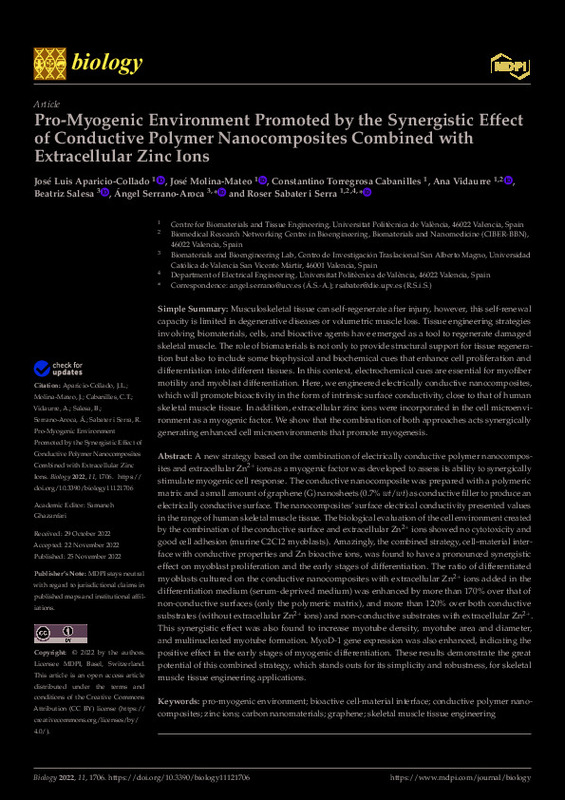|
Resumen:
|
[EN] Musculoskeletal tissue can self-regenerate after injury, however, this self-renewal capacity is limited in degenerative diseases or volumetric muscle loss. Tissue engineering strategies involving biomaterials, cells, ...[+]
[EN] Musculoskeletal tissue can self-regenerate after injury, however, this self-renewal capacity is limited in degenerative diseases or volumetric muscle loss. Tissue engineering strategies involving biomaterials, cells, and bioactive agents have emerged as a tool to regenerate damaged skeletal muscle. The role of biomaterials is not only to provide structural support for tissue regeneration but also to include some biophysical and biochemical cues that enhance cell proliferation and differentiation into different tissues. In this context, electrochemical cues are essential for myofiber motility and myoblast differentiation. Here, we engineered electrically conductive nanocomposites, which will promote bioactivity in the form of intrinsic surface conductivity, close to that of human skeletal muscle tissue. In addition, extracellular zinc ions were incorporated in the cell microenvironment as a myogenic factor. We show that the combination of both approaches acts synergically generating enhanced cell microenvironments that promote myogenesis.
Abstract
A new strategy based on the combination of electrically conductive polymer nanocomposites and extracellular Zn2+ ions as a myogenic factor was developed to assess its ability to synergically stimulate myogenic cell response. The conductive nanocomposite was prepared with a polymeric matrix and a small amount of graphene (G) nanosheets (0.7% wt/wt) as conductive filler to produce an electrically conductive surface. The nanocomposites¿ surface electrical conductivity presented values in the range of human skeletal muscle tissue. The biological evaluation of the cell environment created by the combination of the conductive surface and extracellular Zn2+ ions showed no cytotoxicity and good cell adhesion (murine C2C12 myoblasts). Amazingly, the combined strategy, cell¿material interface with conductive properties and Zn bioactive ions, was found to have a pronounced synergistic effect on myoblast proliferation and the early stages of differentiation. The ratio of differentiated myoblasts cultured on the conductive nanocomposites with extracellular Zn2+ ions added in the differentiation medium (serum-deprived medium) was enhanced by more than 170% over that of non-conductive surfaces (only the polymeric matrix), and more than 120% over both conductive substrates (without extracellular Zn2+ ions) and non-conductive substrates with extracellular Zn2+. This synergistic effect was also found to increase myotube density, myotube area and diameter, and multinucleated myotube formation. MyoD-1 gene expression was also enhanced, indicating the positive effect in the early stages of myogenic differentiation. These results demonstrate the great potential of this combined strategy, which stands outs for its simplicity and robustness, for skeletal muscle tissue engineering applications.
[-]
|
|
Agradecimientos:
|
This research was funded by Spanish Ministry of Science and Innovation (MCINN, Agencia Estatal de Investigación/FEDER funds) through the RTI2018-097862-B-C21 (awarded to R.S.S. and J.M-M.) and PID2020-119333RB-I00/AEI/10 ...[+]
This research was funded by Spanish Ministry of Science and Innovation (MCINN, Agencia Estatal de Investigación/FEDER funds) through the RTI2018-097862-B-C21 (awarded to R.S.S. and J.M-M.) and PID2020-119333RB-I00/AEI/10.13039/501100011033 (awarded to Á.S-A.) projects,x]. CIBER-BBN is an initiative funded by the VI National R & D & I Plan 2008¿2011, Iniciativa Ingenio 2010, Consolider Program, CIBER Actions were financed by the Instituto de Salud Carlos III with assistance from the European Regional Development Fund.
[-]
|









